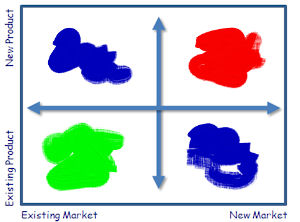Following up on my post here yesterday about this being a good time for planning, I want to share this framework for looking at different kinds of business growth, in terms of capital costs and resources.

Take your possible growth efforts and classify them into the general categories shown in my drawing here to the right. Rate each growth opportunity based on two scales:
- On the vertical, rate each growth idea by how new the product (or service, or business offering) is, on a scale of 1 to 10 with a 1 being your existing current stuff and a 10 completely new business offerings you’d have to develop.
- On the horizontal, rate each growth idea according to how well you know the target market, from a 1 for your current business market to a 10 for completely new markets you’ve never worked with before.
Growth in the green quadrant, selling existing products to existing customers, is by far the easiest. That is viewed in terms of capital requirements, resources, investment, time effort, and so on. Growth in the red quadrant, creating new products for new markets, is way more expensive.
Growth in the two blue quadrants falls somewhere in between. That’s selling new things to existing customers, or finding new customers to buy existing things.
In practical terms, most businesses can finance that growth in sales of existing product to existing market through existing revenues, but most companies need outside support to develop new products for new markets.
The difference is often enormous. For example, a computer company studied 800 retail dealers over three years, and classified their growth drivers according to this simple model. Sure, this was all vague and rounded, and required a lot of educated guessing. What they found was that growth in the green quadrant costs about $0.15 in capital per dollar of increased sales. Growth in the red quadrant cost an average of $0.75 in capital per dollar of increased sales. Growth in the blue varied from $0.30 to $0.55 per dollar of sales growth. Those are old numbers in one special study, so don’t take them as still valid in dollars and cents; but they’re still true conceptually. What’s still true today is that some business growth is way more easily attained than some other business growth.
And I’m not talking about sales, or costs, or expenses here: I’m talking about new capital, as in new funding. I’m talking about either investment that dilutes your ownership, or borrowing that adds to your debt. These are tough trade-offs.
It doesn’t take a lot of math or theory to figure out why; we’re human, we make mistakes. It’s not just theory. Trying to develop new markets costs a lot more because we grope a bit, do it wrong, and learn the hard (and expensive) way. Trying to develop new products is also hard and expensive. I know software pretty well. We choose the wrong platforms, we try the wrong routines, we have to stop and go back sometimes. That all adds up to costs.
And then there’s the so-called rub. If you don’t move toward new products and new markets, eventually, you go stale and the business dries up. There’s a lot of paradox in business planning.
Conclusion: make sure you address existing customers first. You can’t keep a business healthy for too long without new products and new customers, for sure; but plan your growth well.
By the way, this isn’t just my idea, although I’ve seen the practical reality of this for several decades. It isn’t my original thinking. I heard it first from another consultant. I’m told this is the Ansoff Matrix model, which was originally developed at Harvard Business School.




Comments
[…] for contiguous growth first. Not all growth is created equal. Selling an existing product to existing customers is way easier than selling a new product to new […]
Thank you! I work in marketing at a non-profit with a board of directors who is consistently focused on the red quadrant, while I’ve been trying to explain to them the reasoning behind why we focus our limited resources on the blue and green quadrants. Hopefully this article will help them understand that it makes good sense for business in any sector.
The numbers nerd in me loves budgeting costs and make cost/benefit calculations for business. Of course, the reality often varies from the planning by very significant amounts! I believe that I have seen this grid before but thanks for bringing it back to my attention, if anything I can trot it out while I talk to my clients and partners and add a little intellectual gravitas to our year end planning sessions.